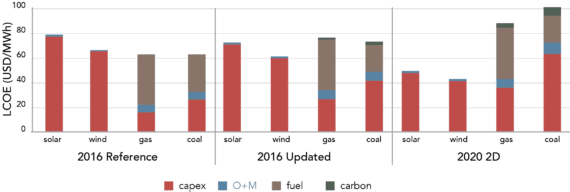According to a new report from the independent financial think tank Carbon Tracker Initiative, renewable power generation costs are already lower on average worldwide than fossil fuels.
The new sensitivity analysis published by Carbon Tracker this week, End of the load for coal and gas? makes the bold claim that renewable power generation costs are already lower on average worldwide than generation costs of fossil fuels, and that clean energy plants are only going to become more cost-competitive by 2020.
The report’s authors clarify further, however, by explaining that their findings are based on Levelized Costs of Electricity (LCOEs), and that there are “widely recognized … large ranges of values for each technology” within a technology’s LCOE. In the end, the authors note that,
the answer to the question “Which is the cheapest?”; is: “It depends”.
The report applies a Levelized Cost of Electricity sensitivity analysis across three separate scenarios — the 2016 reference case scenario, an updated 2016 scenario, and a 2020 2˚C pathway setting, where investment decisions take into account decarbonization trends.
Specifically, the report takes into account the reduced load factors and shorter lifetimes for coal and gas plants in a world which is steadily decarbonizing, which the authors believe “significantly undermine plant economics.”
“Policy-makers and investors really need to question outdated assumptions on technology costs that do not factor in the direction of travel post-Paris,” said Carbon Tracker’s head of research James Leaton. “Planning for business-as-usual load factors and lifetimes for new coal and gas plants is a recipe for stranded assets.”
“This analysis explains why renewables are already the cheapest option in a number of markets,” added Paul Dowling co-author of the report. “This trend is only likely to spread as the growth of renewables undermines the economics of fossil fuels.”
Specifically, the report found that by 2020, falling utilization rates under a 2˚C scenario finds plant capacity factors for coal and gas drop to an average of 42% for coal and 31% for gas, resulting in an increase in costs of $16/MWh and $38/MWh respectively.
Conversely, if solar and wind delivered capacity factors of 20% and 40% respectively, they would cut their LCOE by $6/MWh and $15/MWh.
“Markets are having to deal with integrating variable renewables on a growing scale,” explained senior analyst and co-author Matt Gray. “Rather than continue debating whether this energy transition is already occurring, it is time to focus on developing the opportunities in energy storage and demand management that can smooth the process.”
Source: Cleantechnica. Reproduced with permission.










